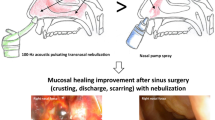Abstract
Chronic rhinosinusitis may cause olfactory dysfunction and affects quality of life in patients. In a prospective study we investigated the effect of topical application of corticosteroids through pressure-pulsed inhalation as treatment option of chronic rhinosinusitis with olfactory disorder. Patients with sinonasal olfactory disorder according to the European Position Paper on Rhinosinusitis and Nasal Polyps (EP3OS) were allocated to the new nasal inhalation therapy or a systemic corticosteroid therapy, each receiving a corticosteroid course of 12 days. 18 patients received topical corticosteroid pressure-pulsed inhalation (AMSA, Schumacher, Dausenau) and 15 systemic corticosteroid. Olfactory function was measured before and after treatment using the Threshold Discrimination Identification score (TDI score) and visual analogue scales. Lund Mackay score (LMS) was measured before starting treatment. Olfactory function (OF) increased from 17.5 ± 6.4 to 21 ± 7.9 TDI points (p < 0.0005) after 2 months. OF decreased again to 19.5 ± 6.0 after 6 months (p = 0.007). OF increased from 17.0 ± 8.9 to 22.0 ± 9.5 points (p = 0.002) with systemic treatment after 2 months. In the follow-up period of 6 months, the mean TDI score dropped to 20.0 ± 9.2 points (p = 0.01). There was no correlation between LMS and TDI. Treatment of chronic rhinosinusitis with pressure-pulsed inhalation was demonstrated to be effective. Multicenter investigations with large participant numbers are needed.
Similar content being viewed by others
References
Eccles R (2011) Mechanisms of the symptoms of rhinosinusitis. Rhinology 49:131–138
Hummel T, Nordin S (2005) Olfactory disorders and their consequences for quality of life. Acta Otolaryngol 125:116–121
Bramerson A, Johansson L, Ek L, Nordin S, Bende M (2004) Prevalence of olfactory dysfunction: the skövde population-based study. Laryngoscope 114:733–737
Mott AE, Leopold DA (1991) Disorders in taste and smell. Med Clin North Am 75:1321–1353
Jafek BW, Murrow B, Michaels R, Restrepo D, Linschoten M (2002) Biopsies of human olfactory epithelium. Chem Senses 27:623–628
Klimek L, Eggers G (1997) Olfactory dysfunction in allergic rhinitis is related to nasal eosinophilic inflammation. J Allergy Clin Immunol 100:158–164
Fokkens W, Lund V, Mullol J et al (2007) European position paper on rhinosinusitis and nasal polyps 2007. Rhinol Suppl 20:1–136
Damm M, Temmel A, Welge-Lüssen A et al (2004) Riechstörungen—Epidemiologie und Therapie in Deutschland, Österreich und der Schweiz. HNO 52:112–120 Article in German
Stevens MH (2001) Steroid-dependent anosmia. Laryngoscope 111:200–203
Ikeda K, Sakurada T, Suzaki Y, Takasaka T (1995) Efficacy of systemic corticosteroid treatment for anosmia with nasal and paranasal sinus disease. Rhinology 33:162–165
Jankowski R, Bodino C (2003) Olfaction in patients with nasal polyposis: effects of systemic steroids and radical ethmoidectomy with middle turbinate resection (nasalisation). Rhinology 41:220–230
Scott AE (1989) Caution urged in treating ‘steroid-dependent anosmia’. Arch Otolaryngol Head Neck Surg 115:109–110
Benninger MS, Ahmad N, Marple B (2003) The safety of intranasal steroids. Otolaryngol Head Neck Surg 129:739–750
Heilmann S, Huettenbrink KB, Hummel T (2004) Local and systemic administration of corticosteroids in the treatment of olfactory loss. Am J Rhinol 18:29–33
Scheibe M, Bethge C, Witt M, Hummel T (2008) Intranasal administration of drugs. Arch Otolaryngol Head Neck Surg 134:643–646
Lund VJ, Mackay IS (1993) Staging in rhinosinusitis. Rhinology 107:183–184
Oluwole M, Russell N, Tan L et al (1996) A comparison of CT staging systems in chronic sinusitis. Clin Otolaryngol Allied Sci 21(1):91–95
Ashraf N, Bhattacharyya N (2001) Determination of the incidental Lund-Mackay score for the staging of chronic rhinosinusitis. Otolaryngol Head Neck Surg 125:436–438
Hummel T, Sekinger B, Wolf SR, Pauli E, Kobal G (1997) “Sniffin’ Sticks”: olfactory performance assessed by the combined testing of odor identification, odor discrimination and olfactory threshold. Chem Senses 22:39–52
Kobal G, Klimek L, Wolfensberger M, Gudziol H, Temmel A, Owen CM, Seeber H, Pauli E, Hummel T (2000) Multicenter investigation of 1036 subjects using a standardized method for the assessment of olfactory function combining tests of odor identification, odor discrimination, and olfactory thresholds. Eur Arch Otorhinolaryngol 257:205–211
Hummel T, Kobal G, Gudziol H, Mackay-Sim A (2007) Normative data for the “Sniffin’ Sticks” including tests of odor identification, odor discrimination, and olfactory thresholds: an upgrade based on a group of more than 3000 subjects. Eur Arch Otorhinolaryngol 264:237–243
Landis BN, Konnerth CG, Hummel T (2004) A study on the frequency of olfactory dysfunction. Laryngoscope 114:1764–1769
Shu CH, Lee PO, Lan MY, Lee YL (2011) Factors affecting the impact of olfactory loss on the quality of life and emotional coping ability. Rhinology 49:337–341
Wilson R, Sykes DA, Chan KL et al (1987) Effect of head position on the efficacy of topical treatment of chronic mucopurulent rhinosinusitis. Thorax 42:631–632
Author information
Authors and Affiliations
Corresponding author
Rights and permissions
About this article
Cite this article
Goektas, O., Lau, L. & Olze, H. Treatment of Chronic Rhinosinusitis with Pressure-Pulsed Corticosteroid Inhalation. Indian J Otolaryngol Head Neck Surg 65 (Suppl 2), 402–405 (2013). https://doi.org/10.1007/s12070-013-0625-y
Received:
Accepted:
Published:
Issue Date:
DOI: https://doi.org/10.1007/s12070-013-0625-y




